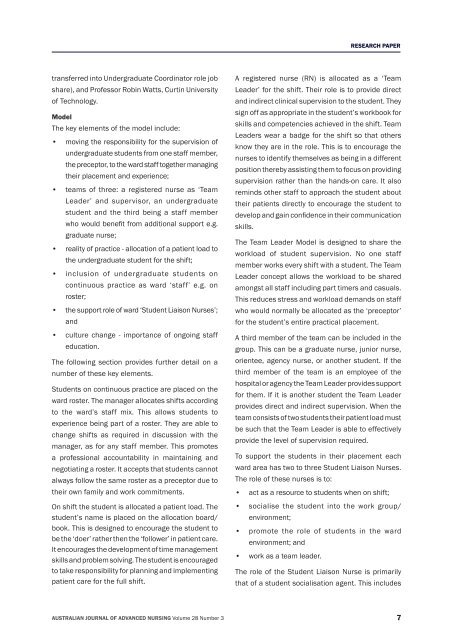australian journal of advanced nursing
australian journal of advanced nursing
australian journal of advanced nursing
Create successful ePaper yourself
Turn your PDF publications into a flip-book with our unique Google optimized e-Paper software.
transferred into Undergraduate Coordinator role job<br />
share), and Pr<strong>of</strong>essor Robin Watts, Curtin University<br />
<strong>of</strong> Technology.<br />
Model<br />
The key elements <strong>of</strong> the model include:<br />
•<br />
•<br />
•<br />
•<br />
•<br />
•<br />
moving the responsibility for the supervision <strong>of</strong><br />
undergraduate students from one staff member,<br />
the preceptor, to the ward staff together managing<br />
their placement and experience;<br />
teams <strong>of</strong> three: a registered nurse as ‘Team<br />
Leader’ and supervisor, an undergraduate<br />
student and the third being a staff member<br />
who would benefit from additional support e.g.<br />
graduate nurse;<br />
reality <strong>of</strong> practice ‑ allocation <strong>of</strong> a patient load to<br />
the undergraduate student for the shift;<br />
inclusion <strong>of</strong> undergraduate students on<br />
continuous practice as ward ‘staff’ e.g. on<br />
roster;<br />
the support role <strong>of</strong> ward ‘Student Liaison Nurses’;<br />
and<br />
culture change ‑ importance <strong>of</strong> ongoing staff<br />
education.<br />
The following section provides further detail on a<br />
number <strong>of</strong> these key elements.<br />
Students on continuous practice are placed on the<br />
ward roster. The manager allocates shifts according<br />
to the ward’s staff mix. This allows students to<br />
experience being part <strong>of</strong> a roster. They are able to<br />
change shifts as required in discussion with the<br />
manager, as for any staff member. This promotes<br />
a pr<strong>of</strong>essional accountability in maintaining and<br />
negotiating a roster. It accepts that students cannot<br />
always follow the same roster as a preceptor due to<br />
their own family and work commitments.<br />
On shift the student is allocated a patient load. The<br />
student’s name is placed on the allocation board/<br />
book. This is designed to encourage the student to<br />
be the ‘doer’ rather then the ‘follower’ in patient care.<br />
It encourages the development <strong>of</strong> time management<br />
skills and problem solving. The student is encouraged<br />
to take responsibility for planning and implementing<br />
patient care for the full shift.<br />
RESEARCH PAPER<br />
A registered nurse (RN) is allocated as a ‘Team<br />
Leader’ for the shift. Their role is to provide direct<br />
and indirect clinical supervision to the student. They<br />
sign <strong>of</strong>f as appropriate in the student’s workbook for<br />
skills and competencies achieved in the shift. Team<br />
Leaders wear a badge for the shift so that others<br />
know they are in the role. This is to encourage the<br />
nurses to identify themselves as being in a different<br />
position thereby assisting them to focus on providing<br />
supervision rather than the hands‑on care. It also<br />
reminds other staff to approach the student about<br />
their patients directly to encourage the student to<br />
develop and gain confidence in their communication<br />
skills.<br />
The Team Leader Model is designed to share the<br />
workload <strong>of</strong> student supervision. No one staff<br />
member works every shift with a student. The Team<br />
Leader concept allows the workload to be shared<br />
amongst all staff including part timers and casuals.<br />
This reduces stress and workload demands on staff<br />
who would normally be allocated as the ‘preceptor’<br />
for the student’s entire practical placement.<br />
A third member <strong>of</strong> the team can be included in the<br />
group. This can be a graduate nurse, junior nurse,<br />
orientee, agency nurse, or another student. If the<br />
third member <strong>of</strong> the team is an employee <strong>of</strong> the<br />
hospital or agency the Team Leader provides support<br />
for them. If it is another student the Team Leader<br />
provides direct and indirect supervision. When the<br />
team consists <strong>of</strong> two students their patient load must<br />
be such that the Team Leader is able to effectively<br />
provide the level <strong>of</strong> supervision required.<br />
To support the students in their placement each<br />
ward area has two to three Student Liaison Nurses.<br />
The role <strong>of</strong> these nurses is to:<br />
act as a resource to students when on shift;<br />
AUSTRALIAN JOURNAL OF ADVANCED NURSING Volume 28 Number 3 7<br />
•<br />
•<br />
•<br />
•<br />
socialise the student into the work group/<br />
environment;<br />
promote the role <strong>of</strong> students in the ward<br />
environment; and<br />
work as a team leader.<br />
The role <strong>of</strong> the Student Liaison Nurse is primarily<br />
that <strong>of</strong> a student socialisation agent. This includes

















